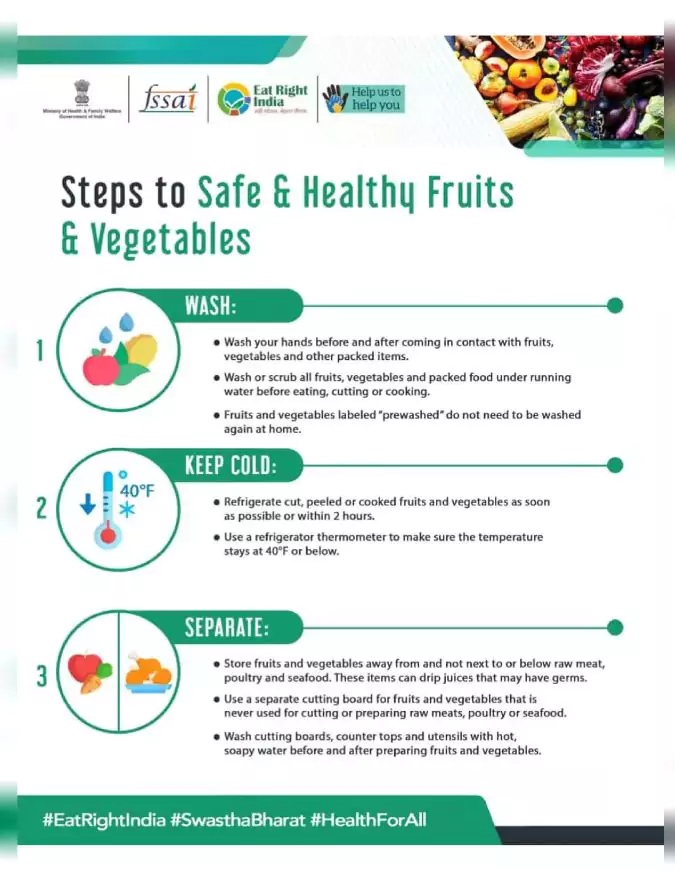‘FSSAI Fruits and Vegetables Safety Guidelines’ PDF Quick download link is given at the bottom of this article. You can see the PDF demo, size of the PDF, page numbers, and direct download Free PDF of ‘FSSAI Fruits and Vegetables Safety Guidelines’ using the download button.
FSSAI Fruits and Vegetables Safety Guidelines PDF Free Download

FSSAI Fruits and Vegetables Safety Guidelines
Food and Standards Authority of India (FSSAI) has once again come up with a new initiative called “Clean and Fresh Fruits and Vegetable Market” to ensure the availability of good quality, safe, and hygienic fruits and vegetables to consumers and to boost economic efficiency.
Growth by upgrading the unorganized retail sector of fruits and vegetables, as the organic/inorganic fruit and vegetable market in India is currently unorganized and lacks consumer confidence.
Examples of retail sector categories for fresh produce are:
Organized food supply-Big Bazaar, Reliance Fresh, and Nature’s Basket, etc.
Unorganized food supply-Pavement vendors, pushcart vegetable sellers, or Mandi.
This initiative will integrate local vendors with organized retailers across the country.
FSSAI aims to achieve so through:
- Infrastructure support like cold rooms, waste disposal areas, etc.
- Large-scale training, certification, and capacity building of vendors
- Providing guidelines for hygiene and safety requirements
Some of the salient points of the document released by FSSAI are:
BENCHMARK GUIDELINES
- General Requirements
- The vendors of fruits and vegetables need to be registered/licensed under the Food Safety and Standards (Licensing and Registration of Food Business) Regulations 2011.
- FSSAI Registration/Licence number and Food Safety Display Board (FSDB) with green color code applicable to Fruit & Vegetable retail business shall be displayed on the cart/kiosk/shop.
- Recruitment of a food safety team for communication and reasoning related to clean and fresh fruit and vegetable market.
- Prohibition of the sale of artificially ripened fruits by acetylene gas, commonly known as carbide gas.
- The fruits may be artificially ripened by using ethylene gas obtained from any safe source up to 100 ppm. The source of ethylene gas shall not come in direct contact with fruits.
- Stickers without any relevant information such as grade, price, bar code, traceability, etc.
should not be used directly on fruits and vegetables. In case they are used, they must
not have any adverse effect on health. - Usage of a functional barrier preventing stickers from directly on fruits and vegetables. A few fruits may be packed in a transparent thin film of good quality.
- All fruits and vegetables sold in the market shall be free from coloring matter, mineral oils, or any other harmful chemicals.
- Wax coating of fruits shall be done only with beeswax (white and yellow) or carnauba wax or shellac wax at a level not exceeding Good Manufacturing Practices.
- Every package of fresh fruit if coated with wax shall carry the label “Coated with wax (give name of wax)
- Food Safety and Hygiene Requirements
- Personal Hygiene
- Protective clothing and footwear for all vendors and food handlers.
- Wash hands with soap or detergent and water before starting work and every time after using the toilet.
- Any cuts or wounds to be covered properly and sick vendors should not be allowed to handle fresh produce.
- All staff or sub-contractors should be made aware of the hygiene and health principles before entering a premises or commencing work.
- Location and Facilities
- The location of the market should be away from environmental pollution and industrial area producing toxic gases.
- The premises shall be clean, adequately lighted, and ventilated and have sufficient free space to allow easy movement of persons and materials.
- A designated area for storing packaging material, clothes, shoes, ripening agents, cleaning agents, water, etc. shall be maintained to avoid contact with food products.
- Maintenance of adequate drainage facility.
- Identification of the designated area for loading and unloading of fruits and vegetables in distribution vehicles.
- Installing equipment such as cooling chambers, moisture retention chambers, and ripening chambers at these markets.
- Covering open-air markets, vending shops/stalls/carts/kiosks with canopy, plastic or metal sheets, etc. to prevent fruits and vegetables from direct sunlight, which may result in moisture loss.
- There shall be appropriate toilets and hand washing facilities with clean water, soap. It shall be kept clean and hygienic.
- Entry of wild animals, and pets shall be prevented by fencing, hedges, gates, etc.
- Cleaning and Sanitation
- Platforms or display units shall be of material so as not to affect the fruits and vegetables with metal contaminants, chipping surfaces, paints, loose nails, glass pieces, etc.
- Display units/crates/trays shall be cleaned and disinfected regularly, after use and after any spillages.
- The equipment and cutting tools (knives, boards, etc.), which may come in contact with fruits and vegetables, shall be of rust/corrosion-resistant materials and kept in clean and good condition.
- Handling of Fruits and Vegetables
- Careful handling and stacking of fruits and vegetables when putting on displays to avoid bruising and product damage.
- The organic fruits and vegetables shall be displayed and stored in a manner that shall be distinguishable from the non-organic ones.
- Discarding any fruit or vegetable cut for display after use.
- Regular rotation of fruits and vegetables for sale to follow FIFO (FIFO-first in first out – use items first, which you bought first). The fruits and vegetables which require some time for ripening may be sold upon ripening later.
- Personal Hygiene
| Language | English |
| No. of Pages | 1 |
| PDF Size | 0.04 MB |
| Category | Government |
| Source/Credits | – |
Related PDFs
Uttarakhand Excise Policy 2023-24 PDF In Hindi
Hyundai EXTER Brochure 2023 PDF
Udyam Registration Process & MSME Classification PDF
Advanced Excel Formulas List PDF
FSSAI Fruits and Vegetables Safety Guidelines PDF Free Download
